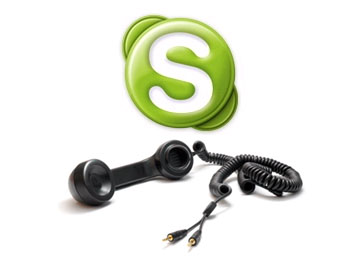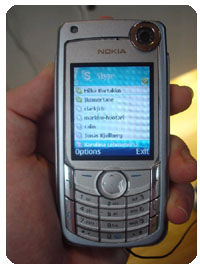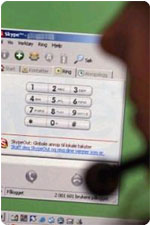Internet+Free+Phone Calls = Skype

With DPH-540, a VoIP phone that lets you make free calls anywhere you can find a WiFi hotspot.
Skype is the famous free downloadable client program (versions available for Windows, MacOS X, Linux, and Pocket PC) from Skype Technologies Limite (www.skype.com) that lets you do free voice sessions ("tlephone calls") with other Skype users ... and , for modes perminute fees, makes calls to PSTN phone number ("Skype-Out") and /or let PSTN users call you, on a
PSTN phone number ("SkypeIn"). Other features availabe-some ofr modest fees-inlude voice mail/messaging, call forwarding, conferencing calling, chat, file transfer, and video.The term "free" is arguably an oversimplification - to use Skype, you require acomputer and Internet access - a broadband connection from your home, costing probably between 20 to 60 US dollars a month, or an account with a WiFi hot-spot provider, or an INternet connection to your company office. Then Skype is "free", fust like using email, INstan Messaging, web browsing, and other Internet applications. Still, Skype is impressive.
Here is one example. In December I was flying on Lufthansa, where there was WiFi service on the plane. So I fired up Skype, and called my wife, for 1,7 cents a minute. Passengers next to me were clearly amazed. Is there a "Skype phenomenon"? We think so. It is a disruptive kind of technology, a paradigm shift."
As of early November 2005, skype claimed over 65 million registered users of their software client, with an average of another 170,000 download registrations per day (roughly two per second)! According to analysis done by broadband management Sandvine Incorporated (www.sandvine.come), back in June 2005, "Cals using Skype account for nearly half of the VoIP minutes used (46.2%) and about 40% of the VoIP bandwidth used in NOrth America."
Skype is used in almost every country. It is the number one player in terms of registered users, and Internet voice minutes, in every market that it operates in, including the United States. Not bad for a service that was started in August 2003. Skype was acqured by eBay back in October 2005, for about US$1.3 billion in cash, and nearly that much again in eBay stock. At that time eBay had about twice as many customers as Skype-with only about a 5% overlap.
In addition to its tens of millions of users, Skype has assembled remarkable partner momentum in the form of hardware, software and service relations, plus third--party develpers. But Skype also raises a number of questions
For VoIP - Timing is Everything

Skype running on Nokia 6680 S60 Handset
Net2Phone had free PC-to-PC phone calls six years ago, but it is hard to make money on it. Net2Phone was the voice backbone for AOL's IM, ICQ, and others but broadband wasn not there to support it. Today, you can see voice as the driver for other business models. What was needed for a service like Skype to emerge was cheap broadband, along with VoIP, increased PC power, and the acceptance of Peer-to-Peer (P2P) technology, where participating systems communicate directly with each other, working as peers. Like, say, the popular/notorious file-sharing services for music, viceos, and other media content the Internet has become popular/notorious for, such as Napster or KaZaA.

Yellow Pelican case for
Qualcomm/Globalstar GSP1600
Skype uses a P2P (peer-to-peer) architecture, so it's perhaps no surprise that both Skype CEO and Skype co-founder also previously co-founded the KaZaA file-shring network. Indeed, the resource-sharing aspect of P2P is there. By becoming a Skype user, you agree to let Skype use an undefined slice of your computer and your network bandwidth, in the service of other customers, even if you are away from your computer. To be fair, you are benefiting from other peoples' computers and networks, but it is a relationship with no control, and, not surprisingly, many service providers are less than happy about hteir bandwidth being used by people who are not their customers.
Skype's Partner and Developers
Skype encourages partners and develpers. For example, ever since they made their API available, more than 400 hardware and software products have been developed that integrate with Skype. As of NOvember 2005, there were over w00 hardware devices labeled 'Skype compatible' or 'Skype certified', and over 1000 developers building applications using the Skype APIs. 30 or more partnerships are with brand-name global businesses, like Siemens, Logitech, Motorola, Intel, BenQ, and Vtech.
For people not ready to surrender their POTS access, RTX America's USB Cordless DUALphone provides a cordless DECT (Digital Enhanced Cordless Telecom) telephone that connects to both your computer and your PSTN line. RTX's Skype value-add is being able to display the buddy list on the handset, so you don't need to be on the PC to place a call. The DUALphone is the only one today that offers wideband audio.
Products built around Skype APIs include prouductivity aplications for small business such as Pamela Systems' 'personal assistant'. jube (www.jube.com) has built community applications for document sharing and real-time collaboration using web presence. Festoon (www.festooninc.com) and Spntaneo have built video applications. Other Skype-oriented applications include Dial MP3, which lets you listen to any MP3 in your collection on your phone. Similarly, existing software vendors are integrating Skype into their offerings. Mobile Internet phone company iSkoot (www.iskoot.com) offers Call Forwarding software for Skype.
On the Opposing Side
Not everybody feels Skype is the right answer,, for a variety of reasons.
Security is a big one. There's the lack of information about what happens inside Skype, and Skype traffic can slip right throught firewalls and NAT (etwork Address Translation). While there is no evidence to suggest there is a danger, Skype could easily be the avenue for a major Internet-carried exploit.
Bandwidth usage is another concern; carriers and service providers feel that their bits are used by people who are not customers and service providers feel that they are missing the chance to earn money carrying these phone calls.
How Skype routes calls, which is not up to users, is also a concern, not just because it is using "other people's bandwidth" but also because Skype is not necessarily picking the shortest, most cost-effective route.
In a recent test where Skype called from one subnet to another, our trace results show that Skyp's routing algorithm doesn't always pick the best path.For example, we saw local calls being routed via the UK, South America ... Who knows how many other backbones are being traversed, which weren't intended as being used by Skype. So sometimes bandwidth is being wasted.
Respnses to Skype include Skype monitors/blockers, an alternative offering which will possibly be not as inexpensive, and offer more insight and control.
For example Verso Technologies (ww.verso.com) NetSpective M-Class filter can block Skype VoIP calls as well as other peer-to-peer applications. Verso began researching how to detect annd block Skype traffic in late 2004. In addition to the bandwidth-sharing authorized by the user agreement, the nature of the Skype protocol is a concern. It is virtualy 'unblockable'. The protocol is very sophisticated, designed to penetrate firewalls, and penetrate NAT. It's designed to make connections. That means it doesn't play well with corporate environments. And since Skype packets are encrypted, it is very difficult to even monitor or track what is going on in the protocol.
End-to-end encryption also means that Skype traffic can't readily be monitored which can cause a problem in the US. And since Skype can also carry chat and streaming media, that makes it a potential carrier for traffic that's illegal in the US.
Most VoIP products use a recognizable protocol that a sniffer or other trace tool lets you see. The way Skype has chosen to do things, those signs aren't there, so iti is a bit of a challenge to recognize its fingerprint and stop it.
What is next for Skype?
Whith lots of users and big bucks already garnered, what i sntext for Skype? Year One was opening up this easy and simple P2P system that allows free voice calls over the web, and Year Two was layering premium service on top of this, like In, Out and Voice mail. Year Threewe see being about trends, growing the platform and ecosysem, the hardware and software partnerships, digital goods, and taking Skype beyond the desktop. During this year they have launched Skype for Pocket PCs. We will see it for more handheld form factors like WiFi phones.
Also watch for SMB and enterprise oriented Skype offerings, provided that skype can master, and offer competitively acceptable solutions that meet business requirements for reliability, performance, and security. We will either see partnerships, to make sure they can guarantee end-to-end quality, or Skype will become a front end for services that will be delivered jointly.
Skype running on Nokia 6680 S60 Handset
In February 2006 Skype announced a partnership with Hutchinson to put Skype on phones on the 3 networks around the world. However, Skype were not willing to answer questions on specific handsets saying only that they were actively working on development for the Symbian platform. However at the 'Do New' booth on the Nokia stand there was a demo of Skype running on two 6680s over a 3G network.
The S60 Skype application was a complete implementation supporting Skype text chat, Skype voice calls (both to PCs and to other S60 handsets), and Skype Out dialing. Running the application over 3G results in latency of up to about a second. It is the equivalent to calling your granny on their other side of the world via a satellite phone. It does work, but it is annoying and I can not see most people being willing to put up with it. It was indicated that better performance would be achieved over a WiFi connectivity link. The call quality was similar to that achieved in a normal call.
The application has been developed for S60 2nd Edition (S60 2.6 to be precise), but Skype are working on a 3rd Edition product which would make sense given the WiFi available in the N80, and Eseries handsets.
We'll be covering more on Skype's plan for mobile soon.